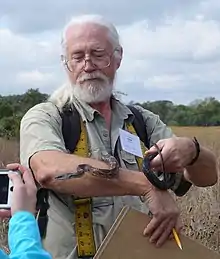David G. Barker
David G. Barker (born January 6, 1952[1]) is an American herpetologist specialized in pythons and rattlesnakes.

Barker graduated in biology at the University of Texas at Arlington, where he additionally served as an instructor in the Department of Biology, and as a preparator in the Museum of Herpetology. From 1975 to 1984 he worked at the Dallas Zoo as its public lecturer and as supervisor in the Reptile House and Children's Zoo. In 1988 he became Curator of Education at the Gladys Porter Zoo.[2] In 1990 he and his wife, biologist Tracy M. Barker, founded Vida Preciosa International, Inc [VPI], an enterprise dedicated to the research necessary to establish self-sustaining captive populations of pythons and boas. This facility became one of the largest and most diverse collection of pythons in the world; in 1997, the Barkers and their work at VPI were featured in a National Geographic Television documentary titled “Passion for Pythons”.[2][3][4] They managed to reproduce 32 of the 52 recognized taxa of pythons. Among them, the first ever reproduction of 12 taxa.[5]
Next to extensive studies on reptiles in captivity, Barker did field work in the United States,[6] Mexico,[6] Indonesia[7] and Australia.[8] His main areas of research are systematics, taxonomy, natural history, animal behavior, morphology, reproductive physiology, captive breeding and animal and plant conservation.
In 1998 he co-authored the description of a new species of monitor lizard: Varanus yuwonoi [9] and in 2000 the description of three new species of pythons: Morelia clastolepis, Morelia nauta and Morelia tracyae.[10] The later is named in honor of his wife Tracy.
Through 2011, Barker has written several dozen scientific publications, six books, over 70 popular articles and has published more than 500 images of reptiles in books, journals and periodicals.[2] From 1990 through 1993 he additionally served on the editorial board of the magazine Zoo Life.[11] In 1989, Barker was awarded Grand Prize in Sierra Club's 10th Annual Photo Contest.[12] One of his books, Pythons of the World, Volume 2: Ball Pythons, was certified as “The Best Animal Book of 2006” by the Independent Publisher Book Awards.[13]
He also gave hundreds of educational reptile demonstrations and appeared in 1988 on Johnny Carson's Tonight Show.[14] In 2011, Barker testified to the United States congressional committee on Government Oversight and Reform on the issues of restrictive regulations and governmental interference imposed on small business.[2]
Barker is a member of the Boa and Python Specialist Group of the International Union for the Conservation of Nature [IUCN].[2]
Books
- Pythons of the World, Volume 3: The Pythons of Asia and the Malay Archipelago. with Tracy M. Barker and Mark Auliya. VPI Library, Boerne, Texas, 2018. 371 pp.
- The Invisible Ark – In Defense of Captivity. with Tracy M. Barker. VPI Library, Boerne, Texas, 2014. 169 pp.
- Pythons of the World, Volume 2: Ball Pythons: The History, Natural History, Care and Breeding. with Tracy M. Barker. VPI Library, Boerne, Texas, 2006. 321pp.
- Pythons of the World, Volume 1, Australia. with Tracy M. Barker. The Herpetocultural Library, Advanced Vivarium Systems, Lakeside, California, 1994. 171 pp.
- The Ball Python Manual. with Philippe de Vosjoli, Roger Klingenberg and Tracy M. Barker. The Herpetocultural Library, Advanced Vivarium Systems, Lakeside, California, 1994. 76 pp.
- A Field Guide to the Reptiles and Amphibians of Texas. with Judith Garrett, Texas Monthly Press, Austin, Texas, 1987. 225 pp.
References
- Applegarth, John S. 2007. Index of Taxonomic Herpetology, Second Edition. IN: Kraig Adler [ed]. Contributions to the History of Herpetology. Society for the Study of Amphibians and Reptiles. 389 pp.
- D.G. Barker’s CV and list of selected publications, attached to: Statement of David G. Barker Before the House Committee on Oversight and Government Reform September 14, 2011. http://oversight.house.gov/wp-content/uploads/2012/01/9-14-2011_Barker_FlawedRegs_Testimony.pdf
- Harvey B. Lilywhite (2014): How Snakes Work: Structure, Function and Behavior of the World’s Snakes. P 137.
- IMDb account for Passion for Pythons. National Geographic Explorer. Episode aired 15 September 1997: https://www.imdb.com/title/tt2338384/
- Information on pages 3-4 in: D.G. Barker, T.M. Barker (2014). The Invisible Ark – In Defense of Captivity. VPI Library, Boerne, Texas.
- D.G. Barker: Variation, Infraspecific Relationships and Biogeography of the Ridgenose Rattlesnake, Crotalus willardi. (MS thesis) In: Campbell, Jonathan A., and Edmund D. Brodie, Jr. (eds.), The Biology of the Pitvipers. Selva, Tyler, Texas. pp 89-106
- Christopher Knight Carmichael (2007): Phylogeography of the Indonesian Water Python, Liasis Mackloti Ssp. (Squamata: Boidae: Pythoninae): A Comparative Approach Toward Resolving Phylogeny. ProQuest. P 91.
- D.G. Barker, T.M. Barker (1994). Pythons of the World, Volume 1, Australia. The Herpetocultural Library, Advanced Vivarium Systems, Lakeside, California.171 pp.
- Harvey, M. B. & D. G. Barker (1998): A new species of blue- tailed monitor lizard (genus Varanus) from Halmahera Island, Indonesia. – Herpetologica, 54: 34–44.
- M. B. Harvey, D. G. Barker, L. K. Ammerman, P. T. Chippindale (2000): Systematics of Pythons of the Morelia amethistina Complex (Serpentes: Boidae) with the Description of three new Species. Herpetological Monographs 14.139-185.
- Zoo Life. Ingle Publishing Company, Los Angeles, CA. David G. Barker is listed as on the editorial board in every issue published quarterly from January 1990 until December 1993
- Sierra’s 10th Annual Photo Contest Winners. Sierra, November/December 1989. pp 48-57.
- Independent Publisher. Judging Results in 65 National Categories. http://www.independentpublisher.com/article.php?page=1157
- R. Wiseman. Borene resident shared the stage with Carson. Boerne Star & Recorder. Tuesday, February 1, 2005. P 1-2.